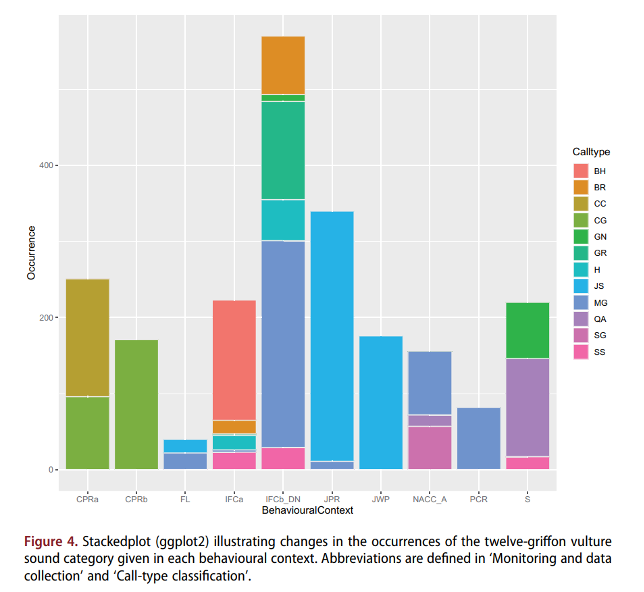
Did we underestimate the complexity of the vocal repertoire of Griffon Vultures? A case study using the Griffon Vulture in Italy shares new insight on the meaning of their vocalisations in relation to social interactions and communication between individuals.
Overview
Animals have evolved sophisticated communication signals to efficiently transmit information regarding their environment or the availability of sexual partners. Amongst vertebrates, sound communication has important consequences for the fitness of individuals.
In this context, numerous studies have focused on Passeriformes that can produce complex vocal emissions called ‘songs’, thanks to a highly specialised syrinx. However, acoustic communications in Accipitriformes have not aroused so much interest due to the lower general complexity of their vocal emissions.
Among this order, Gyps vultures are an exception since they have frequent social interactions, form important colonies and forage cooperatively. Despite the overall good level of knowledge on Gyps vulture ecology, the complexity of their vocal communications in relation to social and foraging interactions remain poorly understood.
Past research has shown that species living in groups with complex social structures would have higher communication skills. In addition, cognitive abilities appear to be proportional to the complexity of vocal communications in several animal species, i.e. the ‘Social Intelligence Hypothesis’.
The aim of this study, led by Dr. Federico Romani from the University of Pavia, Italy, was i) to describe the vocal repertoire of Eurasian Griffon Vultures (Gyps fulvus) in adults, subadults and juveniles and ii) to associate identified vocalisation categories with specific behavioural and ecological contexts.
Methods
Acoustic monitoring was carried out in Italy, in the central Apennines (Abruzzo region) at three monitoring sites: 2 breeding and roosting sites (2 sites with different levels of anthropic influence) and one supplementary feeding station. All vocalisations were recorded between April and October 2019 using acoustic and manual recordings in all the selected monitoring areas.
In addition, the researchers identified 13 behavioural contexts from direct observations at the monitoring sites in order to associate the sounds with specific behaviours:
- Flight (FL)
- Non-Aggressive Close Contact (NACC), when individuals are in the proximity of non-aggressive conspecifics
- Intraspecific Food Competition a (IFCa), individuals competing for trophic resources without direct attack but with warning signs
- Intraspecific Food Competition b (IFCb), individuals competing for a trophic resource through fight
- Defence of the Nest (DN)
- Presence of Danger (PD)
- Chicks and Parents Relation a (CPRa), when the chicks request food after the arrival of one of the two parents at the nest
- Chicks and Parents Relation b (CPRb), when the chicks emit vocalisations not necessarily associated with food
- Parents and Chicks Relation (PCR), when the parents are close to the chicks or one of them returns to the nest
- Juvenile and Parents Relation (JPR), when the juveniles are in or nearby the nest with the parents
- Juvenile Without Parents (JWP), when the juveniles are in or nearby the nest without their parents
- Allopreening (A), when two individuals clean each other’s plumage
- Stress (S), when individuals are attacked by conspecifics or after gate closing during capture operations
Results
The authors isolated and analysed 542 vocalisations across three age classes: 355 acquired at the supplementary feeding station and 187 at the nesting cliffs. The quantitative analysis of the acoustic parameters enabled to group 455 vocalisations out of 542 into 12 currently identified sound categories:
- Metallic Groan (MG)
- Grunt (GR)
- Bray (BR)
- Quacking (QA)
- Hiss (H)
- Groan (GN)
- Sharp Scream (SS)
- Small Groan (SG)
- Bray Hiss (BH)
- Chicken Groan (CG)
- Chicken Coo (CC)
- Juvenile Scream (JS)
Finally, 2316 vocalisations were associated with 13 behavioural contexts, of which 2,229 belong to the 12 categories of sound catalogued. The authors found a highly significant correlation between sound categories and behavioural contexts. For example, the metallic groan had a strong dependence relationship with the behavioural contexts represented by ‘Non-aggressive close contact’, ‘allopreening’, ‘defence of the nest’, ‘parents and chick relation’ or ‘intraspecific food competition’. ‘Quacking’ had a strong dependence relationship with ‘stress’ and ‘hiss’ with ‘individuals competing for food resources through warning signs only’ or ‘intraspecific food competition through fight’ (see Figure 4).

Conclusions
Overall, the study identified a total of twelve types of calls.
These results revealed that the size of the vocal repertoire of Griffon Vultures appears to be wider or similar to those belonging to other non-passerine species, like Psittaciformes, well known for the complexity of their vocal communications.
The complexity of the vocal repertoire of Griffon Vultures emerged particularly from the analysis of the Metallic Groan. They use this type of call in several behavioural contexts, and it has several sound nuances within the notes of the same vocalisation.. These characteristics have been found in the vocalisations of several mammal species and are often related to the emotional state and social status of the subject. All these elements suggest that the Metallic Groan constitutes a complex and articulated language and may have different meanings when associated with different social situations.
In addition, similar studies should be carried out in other accipitrid species with different social structures to better understand the evolution of vocal communications in this order.
The results also suggested that juveniles had similar vocalisations to adults and sub-adults, except for the Juvenile Screams, which meaning needs further investigation.
In general, this study highlighted a language far more complex than previous observations suggested in the Griffon Vulture and seems to indicate that the complexity of the language must be related to a species’ social evolutionary history rather than its syrinx’s evolution.
Finally, bioacoustics provide a powerful tool to investigate the relevance of the ‘Social Intelligence Hypothesis’ in the Eurasian Griffon Vulture as well as in other poorly studied species.
Source
Federico Romani, Elena Ramella Levis, Mario Posillico, Giancarlo Opramolla & Gianni Pavan (2021). Vocal repertoire of the Eurasian griffon vulture (Gyps fulvus) in the central Apennines: a baseline assessment, Bioacoustics, DOI: 10.1080/09524622.2021.1925591.



